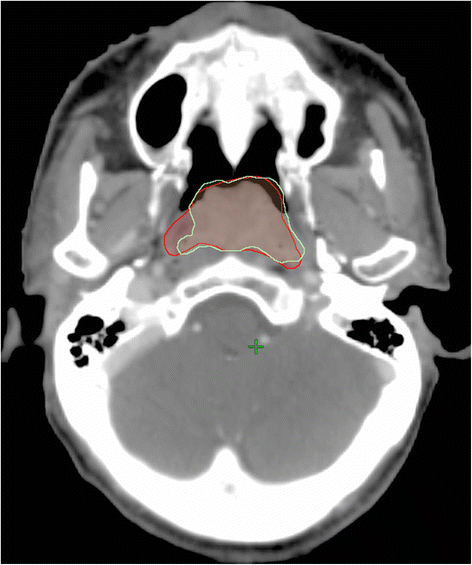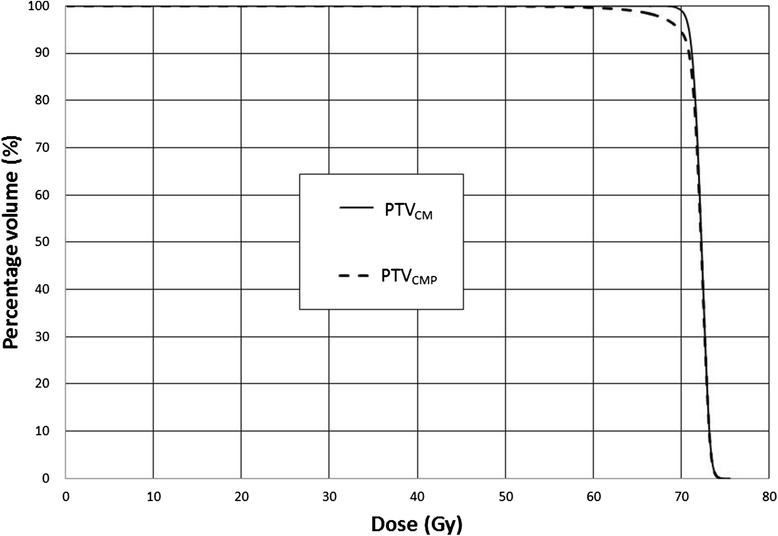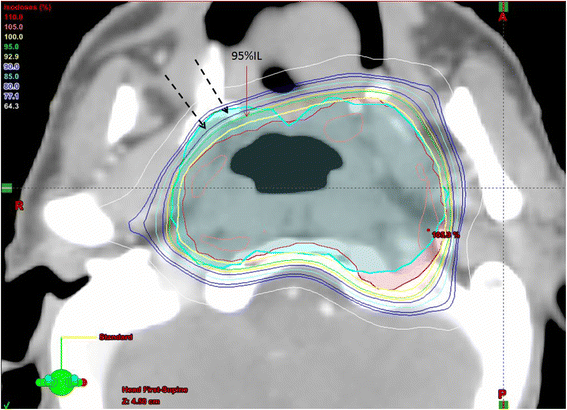The impact of positron emission tomography on primary tumour delineation and dosimetric outcome in intensity modulated radiotherapy of early T-stage nasopharyngeal carcinoma
- PMID: 27558690
- PMCID: PMC4997773
- DOI: 10.1186/s13014-016-0685-8
The impact of positron emission tomography on primary tumour delineation and dosimetric outcome in intensity modulated radiotherapy of early T-stage nasopharyngeal carcinoma
Abstract
Background: In intensity modulated radiotherapy (IMRT) of nasopharyngeal carcinoma (NPC), accurate delineation of the gross tumour volume (GTV) is important. Image registration of CT and MRI has been routinely used in treatment planning. With recent development of positron emission tomography (PET), the aims of this study were to evaluate the impact of PET on GTV delineation and dosimetric outcome in IMRT of early stage NPC patients.
Methods: Twenty NPC patients with T1 or T2 disease treated by IMRT were recruited. For each patient, 2 sets of NP GTVs were delineated separately, in which one set was performed using CT and MRI registration only (GTVCM), while the other set was carried out using PET, CT and MRI information (GTVCMP). A 9-field IMRT plan was computed based on the target volumes generated from CT and MRI (PTVCM). To assess the geometric difference between the GTVCM and GTVCMP, GTV volumes and DICE similarity coefficient (DSC), which measured the geometrical similarity between the two GTVs, were recorded. To evaluate the dosimetric impact, the Dmax, Dmin, Dmean and D95 of PTVs were obtained from their dose volume histograms generated by the treatment planning system.
Results: The overall mean volume of GTVCMP was greater than GTVCM by 4.4 %, in which GTVCMP was slightly greater in the T1 group but lower in the T2 group. The mean DSC of the whole group was 0.79 ± 0.05. Similar mean DSC values were also obtained from the T1 and T2 groups separately. The dosimetric parameters of PTVCM fulfilled the planning requirements. When applying this plan to the PTVCMP, the average Dmin (56.9 Gy) and D95 (68.6 Gy) of PTVCMP failed to meet the dose requirements and demonstrated significant differences from the PTVCM (p = 0.001 and 0.016 respectively), whereas the doses to GTVCMP did not show significant difference with the GTVCM.
Conclusion: In IMRT of early stage NPC, PET was an important imaging modality in radiotherapy planning so as to avoid underdosing the PTV, although its effect on GTV delineation was not significant. It was recommended that PET images should be included in the treatment planning of NPC patients.
Figures



Similar articles
-
18 F-Fluoromisonidazole positron emission tomography/CT-guided volumetric-modulated arc therapy-based dose escalation for hypoxic subvolume in nasopharyngeal carcinomas: A feasibility study.Head Neck. 2017 Dec;39(12):2519-2527. doi: 10.1002/hed.24925. Epub 2017 Sep 30. Head Neck. 2017. PMID: 28963789
-
A new brain positron emission tomography scanner with semiconductor detectors for target volume delineation and radiotherapy treatment planning in patients with nasopharyngeal carcinoma.Int J Radiat Oncol Biol Phys. 2012 Mar 15;82(4):e671-6. doi: 10.1016/j.ijrobp.2011.09.011. Epub 2012 Jan 13. Int J Radiat Oncol Biol Phys. 2012. PMID: 22245187
-
A dosimetric evaluation on applying RTOG-based and CT/MRI-based delineation methods to brachial plexus in radiotherapy of nasopharyngeal carcinoma treated with helical tomotherapy.Br J Radiol. 2019 Oct;92(1102):20170881. doi: 10.1259/bjr.20170881. Epub 2018 May 17. Br J Radiol. 2019. PMID: 29714086 Free PMC article.
-
[Target volume delineation for head and neck cancer intensity-modulated radiotherapy].Cancer Radiother. 2011 Oct;15(6-7):466-72. doi: 10.1016/j.canrad.2011.07.239. Epub 2011 Aug 30. Cancer Radiother. 2011. PMID: 21880533 Review. French.
-
Positron emission tomography for radiation treatment planning.Strahlenther Onkol. 2005 Aug;181(8):483-99. doi: 10.1007/s00066-005-1422-7. Strahlenther Onkol. 2005. PMID: 16044216 Review.
Cited by
-
Claudin1 promotes the proliferation, invasion and migration of nasopharyngeal carcinoma cells by upregulating the expression and nuclear entry of β-catenin.Exp Ther Med. 2018 Oct;16(4):3445-3451. doi: 10.3892/etm.2018.6619. Epub 2018 Aug 20. Exp Ther Med. 2018. PMID: 30233694 Free PMC article.
-
A Formula to Calculate the Threshold for Radiotherapy Targets on PET Images: Simulation Study.Front Oncol. 2020 Oct 21;10:550096. doi: 10.3389/fonc.2020.550096. eCollection 2020. Front Oncol. 2020. PMID: 33194606 Free PMC article.
-
The potential advantages of 18F sodium fluoride positron emission tomography-computed tomography for clinical staging and management planning in patients with nasopharyngeal carcinoma.Quant Imaging Med Surg. 2024 May 1;14(5):3393-3404. doi: 10.21037/qims-23-1671. Epub 2024 Apr 8. Quant Imaging Med Surg. 2024. PMID: 38720843 Free PMC article.
-
Exploring the impact of metabolic imaging in head and neck cancer treatment.Head Neck. 2022 Oct;44(10):2228-2247. doi: 10.1002/hed.27131. Epub 2022 Jul 1. Head Neck. 2022. PMID: 35775713 Free PMC article.
-
The role of PET/CT in radiotherapy for nasopharyngeal carcinoma.Front Oncol. 2022 Oct 21;12:1017758. doi: 10.3389/fonc.2022.1017758. eCollection 2022. Front Oncol. 2022. PMID: 36338692 Free PMC article. Review.
References
-
- Bahl A, Kapoor R, Tomar P, Singh OA, Gupta R, Sharma SC. Dosimetric comparison of doses to organs at risk using 3-D conformal radiotherapy versus intensity modulated radiotherapy in postoperative radiotherapy of periampullary cancers: implications for radiation dose escalation. JOP. 2013;10(14):39–43. - PubMed
MeSH terms
LinkOut - more resources
Full Text Sources
Other Literature Sources
Miscellaneous

